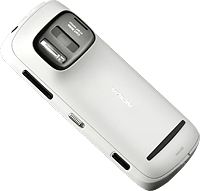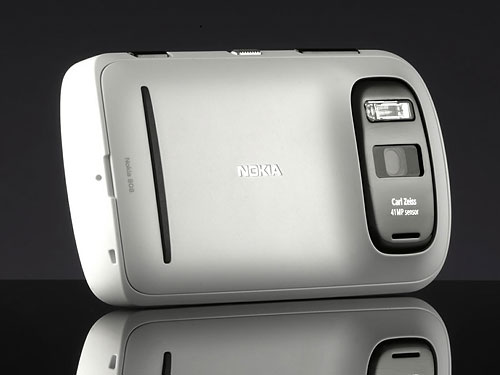Coming to America: 41 megapixel Nokia 808 PureView up for preorder!
posted Thursday, June 21, 2012 at 1:29 AM EDT
 Back at the Mobile World Congress show last February, Nokia announced a phone that elevated pulses of photographers around the world. Dubbed the Nokia 808 PureView, this interesting handset includes a Carl Zeiss-branded lens with an f/2.4 aperture, and an unusually large 1/1.2"-type image sensor. With close to three times the area of the sensors in most compact cameras, and more than five times the area of typical camera phone imagers, the Nokia 808's sensor also offers an uncommonly high resolution of 41 megapixels.
Back at the Mobile World Congress show last February, Nokia announced a phone that elevated pulses of photographers around the world. Dubbed the Nokia 808 PureView, this interesting handset includes a Carl Zeiss-branded lens with an f/2.4 aperture, and an unusually large 1/1.2"-type image sensor. With close to three times the area of the sensors in most compact cameras, and more than five times the area of typical camera phone imagers, the Nokia 808's sensor also offers an uncommonly high resolution of 41 megapixels.
Given that it crams in even more pixels than Nikon's professional D800 and D800E digital SLRs--cameras with much larger 35mm full-frame sensors--one could be forgiven for dismissing the 808 PureView as a marketing gimmick, attempting to vault the company to the top of the spec tables. The pixel size is 1.4 microns, after all--the same size as that of the sensor used by Apple's iPhone 4S, among others. That wouldn't be fair, though, because it's what Nokia has done with all those pixels that makes the 808 an interesting imaging devoice.
Out of the box, the Nokia 808 doesn't save files at anywhere near its true sensor resolution. Instead, the default is to use pixel binning to combine seven sensor pixels into each output pixel in the final image. This not only lowers the resolution to 5.3 megapixels with 4:3 aspect, but it also helps average out the noise, meaning much lower noise levels than you'd expect from the pixel size. (It's also possible to set the resolution to either 8.3 or 2.4 megapixels, or to use the entire 38.4 megapixel resolution of the sensor in 4:3 mode. In 16:9 mode, a different sensor crop yields 33.6 megapixel resolution.)
So... why not just use a five megapixel sensor in the first place? This is where things get clever: by using a higher-resolution sensor, Nokia can mimic an optical zoom despite the fact that the 808--like almost all camera phones--has a fixed focal length lens in the interests of reducing size. When you use the zoom function on other phones, sharpness quickly suffers as more of the image must be interpolated (read: guessed), to fill in the blanks. Since the 808 has all those extra pixels on hand, it can effectively zoom by cropping the image, and then simply reducing the number of sensor pixels being combined into each output pixel. At five megapixel resolution with a 4:3 aspect ratio, this means that roughly 3x zoom is available, without the use of interpolation. (For Full HD video, you can get about 4x zoom, while 720p video allows 6x. There's also a sub-VGA mode matching the phone's display resolution, offering an uninterpolated 12x zoom.)
There are several other advantages of the technique. Since there are no moving parts involved in zooming, the lens design is less complex than an optical zoom, and there's no change in aperture throughout the zoom range. There's also no drive noise induced by zooming. You simply slide your fingertip across the touch screen, and the perceived zoom level instantly and silently changes. Finally, with the lens' actual focal length being fixed, Nokia and partner Carl Zeiss could optimize the lens appropriately, where real optical zoom lenses typically involve a compromise, with varied distortion and aberrations across the zoom range.
Of course, there's no such thing as a free lunch. Nokia's strategy means more work is involved in processing the sensor data to create the final output image, and so necessitated a dedicated companion processor to handle all this scaling. Also, since zooming in reduces the degree of pixel binning taking place (and reaches a maximum when there is no binning at all), this means that image noise levels will increase correspondingly throughout the zoom range, peaking at the levels you'd expect of a sensor with a 1.4 micron pixel size by the time you reach the maximum zoom level. Hence, even though there is no interpolation taking place, quality will degrade as it does when using digital zoom, albeit for different reasons (and in a different manner).
With its focus on imaging, the 808 does make some concessions in other areas. Key among these for many will be the fact that it uses the Symbian Belle OS, which has declined greatly in popularity in the face of Google's Android and Apple iOS operating systems. (Nokia itself announced plans last year to move away from Symbian in its future phones, and transferred development of the operating system to Accenture.) Thanks to the larger than average sensor and lens, it's also quite a bit less svelte than is the norm for a modern smartphone. With a 33mm-equivalent, f/2.4 lens, Apple's iPhone 4S is just 0.37 inches (9.3 mm) thick. HTC's One S--one of the thinnest Android smartphones on the market at just under 0.31 inches (8 mm)--provides a 28mm-equivalent, f/2.0 lens. By contrast, Nokia specs the 808 PureView at 0.55 inches (13.9 mm), and that's not telling the whole story. About the top quarter of the phone around the lens is actually around 0.7 inches (18mm) thick, neatly demonstrating that you can't shoehorn in a larger sensor and brighter lens without paying a price in terms of size. It also has a much lower-resolution screen than many high-end smartphones these days; both the iPhone 4S and HTC One S have more than double the pixel count, and the gorgeous display on the HTC One X (which shares the same imaging functionality as the One S in a slightly thicker package) has four times as many pixels onscreen as the Nokia with a diagonal size only 0.7 inches greater.
Of course, all three of these phones are rumored to be based around the same 1/3.2-inch Omnivision sensor, and none of them can gather anywhere near as much light or offer the same ability to blur backgrounds as the Nokia, nor place as many pixels on your subject. Other phones also typically have LED-based flash, versus a real Xenon flash with red-eye reduction function in the 808. If you're a photographer, these things are important. For those features, the first Nokia PureView model has attracted a lot of attention. There are a lot of photographers out there keen to get better image quality from their phones, and more than a few seem willing to overlook some of the 808's shortcomings to achieve that.
|
|
And so, many have been playing a waiting game to see if the 808 PureView could be headed their way. In the US market, there's been a rather disheartening silence until just recently, when tech site The Verge picked up news that Nokia was working to bring the 808 stateside. The folks at PetaPixel followed up a couple of days ago, with confirmation that the 808 would soon be here, courtesy of a deal with Imaging Resource affiliate partner Amazon.com.
And here, indeed, it is. The Nokia 808 PureView is now available for US customers to preorder, although there's no hiding (and in the process, inflating) the cost with long-term carrier contracts. If you're in the US market and you want the 808, you'll need to pay full retail pricing, and you'll need to be with a carrier compatible with its GSM radio--basically, AT&T, T-Mobile, or a mobile virtual network operator reselling service on either of these company's networks.
If that sounds like something you can live with, you'll probably want to get in line now. The Nokia 808 PureView goes on sale on Amazon from July 8th 2012, and we have a feeling sales are going to be brisk for the foreseeable future. With Amazon as the only official retailer for the phone in the US market, there's going to be no queue-skipping or shopping around for a better deal...
For more details on the Nokia 808 and its unusual PureView technology, the company has provided a white paper outlining how PureView works, and what it feels to be its advantages versus other camera phone designs. More details are also available on the Nokia USA product page. To place an order, visit Amazon.com's product listing for the Nokia 808 PureView.
(via PetaPixel)
